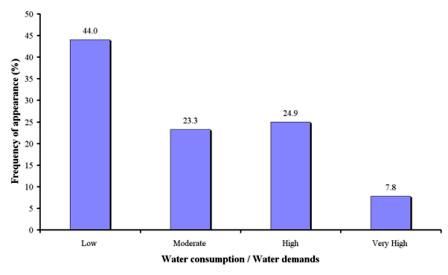Water consumption/water demands
Various concepts may be used to describe the diverse aspects of water use. Water abstraction is the quantity of water physically removed from its natural source. Water supply refers to the share of abstraction which is supplied to users excluding losses in storage, conveyance and distribution. Water consumption signifies the share of supply which in terms of a water balance actually is used (as evaporation), while the remainder is reintroduced into the source of abstraction. The term water demand is defined as the volume of water requested by users to satisfy their needs. In a simplified way, it is often considered equal to water abstraction, although conceptually the two terms do not allow for the same interpretation. This indicator has been estimated for the purposes of the DESIRE project by computing: (a) the amount of water used and (b) the corresponding demands for domestic, industrial, agricultural and other sectors. The percentage of total consumption by each sector dividing the total consumption or by the corresponding demands for each sector determines the indicator. In this project, the total consumption in all sectors versus the total demands has been used. The following classes have been defined for this indicator: (a) low - water consumption/water demands = WC/WD <0.5), ( ) moderate - WC/WD = 0.5-1, (c) high - WC/WD = 1-2, and (d) very high - WC/WD >2. In the case of irrigation WC/WD< 1 poses threats of biomass loss and soil salinization, WC/WD> 1 results in water waste and soil erosion on sloping land.
As Table 2 shows, water consumption/water demands data have been collected in 361 field sites, corresponding to 5 study sites. The obtained data have shown that 44.0% of the study field sites had a low ratio of WC/WD (Fig. 14). This has been observed mainly in the study sites of Djanybek-Russia, Novij Saratov-Russia and partially in the study sites of Crete-Greece and Boteti Area-Botswana. Moderate and high classes of WC/WD have been found in about equal number of study field sites (23.3% and 24.9% of the total field sites, respectively) covering parts of Crete-Greece, Boteti Area-Botswana, and Novij Saratov-Russia. Very high ratio of WC/WD has been computed in the study field sites of Nestos Basin Maggana-Greece.

Fig. 14. Water consumption versus water demands classes prevailing in the study field sites